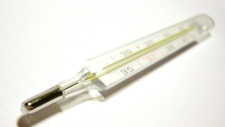Measuring Temperature

TEKS Objective
The student is expected to collect, record, and analyze information using tools, including calculators, microscopes, cameras, computers, hand lenses, metric rulers, Celsius thermometers, prisms, mirrors, pan balances, triple beam balances, spring scales, graduated cylinders, beakers, hot plates, meter sticks, magnets, collecting nets, and notebooks; timing devices, including clocks and stopwatches; and materials to support observation of habitats of organisms such as terrariums and aquariums.
Essential Understanding
The student knows how to use a variety of tools, materials and methods to conduct science inquiry.
Science Background
Temperature Measurement, Thermometers: School for Champions (website) - Information about how a thermometer works, different types of thermometers, and how to calibrate a thermometer.
Temperature Measurement, Thermometers
School for Champions, www.school-for-champions.com
Thermal Energy Physics: Thermalenergy.org (website) - Explains the physical science of thermal energy and relates it to heat, absolute zero, temperature scale and more.
Thermal Energy Physics
Thermalenergy.org
Temperature Scales: School for Champions (website) - Background on the evolution and applications of different temperature scales (Celsius, Kelvin, Fahrenheit), and explanations for converting from one scale to another. This information also could be used as the basis for a history investigation.
Temperature Scales
School for Champions, www.school-for-champions.com
Signature Lesson
Physics in a Bottle, Expanding Thermometers: Physics Central (website) - Students build their own thermometers with a water bottle and a straw; collect, record and analyze temperature data with their instruments, and learn how/why the thermometers work.
Physics in a Bottle, Expanding Thermometers
Physics Central, www.physicscentral.com
- Supporting Lessons
- Extensions
- Assessment Ideas
- Literature Connections
- Related
TEKS - Additional Resources
Supporting Lessons
EnergyWorks: NEED.org (PDF) - Use several activities from this energy workbook. Activities related to temperature begins on page 11.
The Mitten Problem: Power Sleuth (PDF) - This activity uses a familiar experience (using gloves/mittens to keep hands warm) to elicit students’ ideas about heat and temperature, and to promote exploration of students’ developing understanding of heat sources.
Elaboration Lessons and Extensions
Stop Heat from Escaping: TeachEngineering (website) - Students explore the concept of heat (and energy) conservation by testing several materials as insulators.
Stop Heat from Escaping
TeachEngineering, www.teachengineering.org
Assessment Ideas
Interactive Thermometer: Mathisfun.com (website) - Students rank different items identified by an online, interactive thermometer, from coldest to hottest. They can check their answers individually or as a group.
Literature Connections
Temperature: Heating Up and Cooling Down. Stille, D. (ISBN-13: 978-1404803459)
Hot or Cold? Martin, Elena (ISBN-13: 978-0736816984)
Practical Temperature Measuring. Childs, Peter (ISBN-13: 978-0750650809)
Temperature (Measuring the Weather). Rodgers, Alan (ISBN-13: 978-1432900809)
Additional Resources
Temperature Game: NASA (website) - This interactive online game teaches students about the relative temperatures of different locations and objects.
Temperature Game
NASA, funphysics.jpl.nasa.gov
What’s the Weather: FOSSWEB (website) - Cold, hot, warm, cool: what does the temperature mean to you? This interactive animation asks students to help the bear decide what to wear, based on the weather outside.
TEKS Navigation
Grade 5
Need Assistance?
If you need help or have a question please use the links below to help resolve your problem.

Comments